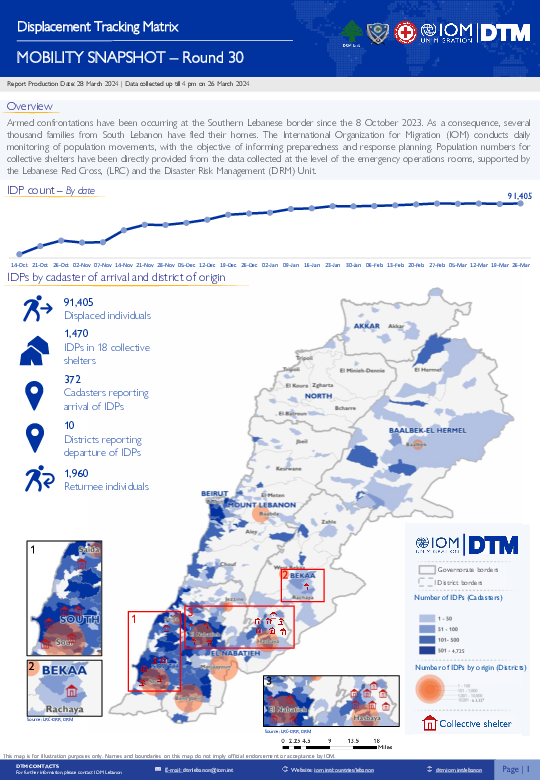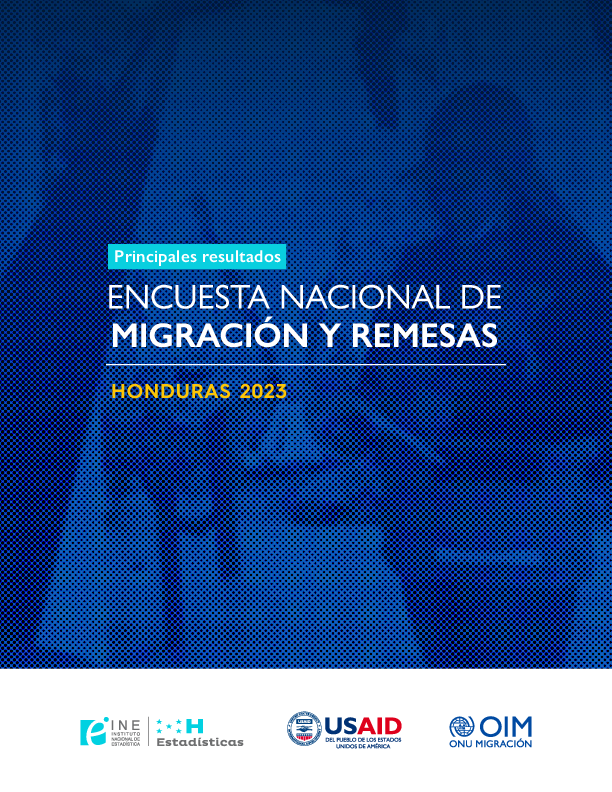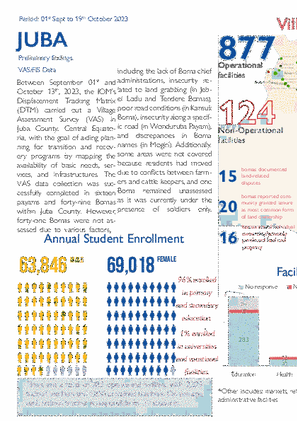-
Countries
-
Data and Analysis
-
Special Focus
-
Crisis Responses
Assessment Report

Contact
DTM Sudan, DTMSudan@iom.int
Language
English
Location
Sudan
Period Covered
Feb 22 2024
Mar 21 2024
Activity
- Mobility Tracking
- Baseline Assessment
This report reflects data corresponding to Monthly Displacement Overview 07 dataset, valid as of 21 March 2024. The dataset is available here.
Overview
IOM DTM Sudan presents its seventh Monthly Displacement Overview. This publication provides an account of Sudan’s displacement context since 15 April 2023 – outlining population mobility and displacement, as well as the present and evolving needs of IDPs across Sudan. It provides further contextual analysis for all 18 states for the period between 22 February and 21 March 2024.
Rationale
Recognizing the need for more detailed insights into the IDP situation, including the priority needs, access to services, movement intentions, and demographic breakdowns of the affected population, DTM Sudan has undertaken a comprehensive review of our data collection tool. In collaboration with a wide range of internal and external stakeholders, we have developed a new tool to better inform humanitarian response operations, aligning with the DTM global methodology. Leveraging our extensive network of approximately 367 field-based enumerators and a robust system of over 3,362 key informants across the country, DTM gathered data on IDPs across 7,037 locations, in 181 of Sudan’s 189 localities, across all of Sudan’s 18 states, during March 2024.
Key Findings
- DTM Sudan estimates that 6,552,118 individuals (1,308,617 households) have been recently internally displaced.
- IOM DTM also reports that an estimated 2,019,027 mixed cross-border movements have been made into neighbouring countries.
- Since 15 April 2023, 46 per cent of the IDP caseload sought refuge in the Darfur and Kordofan regions, whereas 53 per cent were observed across the Northern, Eastern, and Central states.
- The majority of the IDP caseload (66%) were seeking shelter with the host community.
- While food remains the highest priority need, health and non-food items are also growing concerns.

Contact
DTM South Sudan, SouthSudanDTM@iom.int
Language
English
Location
South Sudan
Period Covered
Jul 01 2023
Aug 31 2023
Activity
- Survey
The overall goal of the 2023 humanitarian Inter-Sector Needs Assessment (ISNA) was to collect and analyze data on the needs and vulnerabilities of households, displacement and migration history, shelter and non-food items (SNFI), water, sanitation and hygiene (WASH), health, education, protection, and social cohesion.
The ISNA was intended to fill the information gaps for the 2024 Humanitarian Needs Overview and update the two-year Humanitarian Response Plan (2023-2024). The data collection conducted between July and August 2023, addresses these gaps, while fully respecting accountability to the affected populations and minimizing assessment fatigue.
A total of 12,394 individual household members (hereinafter referred to as 'the survey respondents' or 'respondents') across South Sudan's 10 states and Abyei Administrative Area (here in referred to as 'Abyei') participated in the assessment. Among the total, 62.5 per cent were host community members, 19.7 per cent were returnees, and 17.8 per cent were IDPs. The reported average household size is 5.6 persons per household. The survey targeted heads of households, but in their absence, an individual household member answered on their behalf.
15 per cent of respondents reported having at least one member with a disability, 4 per cent of whom face moderate or severe challenges. This aligns with the WHO's global average. Additionally, chronic illness affects a significant 22 per cent of households, underscoring the need for accessible healthcare within the rural areas of South Sudan
A concerning 48.1 per cent of households have at least one member with a health issue. More critically, 67.9 per cent reported difficulties in accessing healthcare when needed. The primary issues contributing to this are the significant distance to health facilities (50.8%) and lengthy waiting times for services (37.8%). More primary health care and mobile/outreach facilities are needed to address the accessibility and efficiency of healthcare services, ensuring that households in need of health services can promptly receive the care they require.
79.5 per cent indicated that not every individual in their household possesses a valid identification document posing a challenge for the upcoming elections. With 50.7 per cent of the population requiring access to civil documentation, urgent attention is needed to facilitate the documentation process. 39.7 per cent of households reported they attempted to access civil documentation but faced obstacles which is alarming, this underscores the need for interventions to ensure a smooth and accessible documentation process for all citizens. Addressing this is crucial for facilitating democratic participation and ensuring equal civic rights for the entire population.
Enrollment rates among school-aged children were significantly lower in Lakes (57%), Jonglei (53.2%), Northern bahr El Ghazal (52.3%), Unity (52.3%) and Warrap (49.6%) compared to other states in the current school year. Addressing the high rates of school non-enrollment in these states is crucial to improving educational outcomes in these regions.
Nearly 60 per cent of the population needs protective services, yet almost half (46.4%) face roadblocks in accessing them. Movement restrictions due to insecurity affect 24.6 per cent of households, highlighting the urgency to enhance security measures. Additionally, 15.5 per cent express concern about early marriage for girls, emphasizing the need to implement programs to fight early marriage and promote girls’ education. Equally alarming is the 10.4 per cent reporting unlawful detention as a primary protection concern for boys. Immediate attention and targeted programs are essential to address these pressing protection issues.

Contact
dtmlebanon@iom.int
Language
English
Location
Lebanon
Period Covered
Oct 10 2023
Mar 26 2024
Activity
- Mobility Tracking
- Baseline Assessment
Since October 8 there has been an increase in cross-border incidents between Israel and Lebanon, resulting in the displacement of people both within the South and elsewhere within the country. Since October 10, the Displacement Tracking Matrix (DTM) has been conducting the daily monitoring of population movements. The objective of the exercise is to inform preparedness and response planning.

Contact
DTM South Sudan, SouthSudanDTM@iom.int
Language
English
Location
South Sudan
Period Covered
Sep 01 2022
Oct 31 2022
Activity
- Survey
- Return Intention
Between September and October 2022, the International Organization for Migration’s Displacement Tracking Matrix (IOM DTM) undertook its third household-level multi-sector assessment of selected urban areas and camps for internally displaced persons (IDPs) in South Sudan. The assessment aims to:
• Quantify the prevalence of vulnerabilities and humanitarian needs across sectors, with a focus on food security, economic vulnerability and nutrition as well as selected indicators on shelter and non-food items (SNFI), education, health, water, hygiene and sanitation (WASH), protection (including child protection and gender-based violence) and mental health and psycho-social support (MHPSS).
• Generate a better understanding of urban displacement and migration, including return and relocation after displacement in South Sudan or abroad.
There has been slow progress in the humanitarian situation in South Sudan. People’s humanitarian needs continue to rise, driven by cumulative and compounding effects of years of conflict, sub-national violence, food insecurity, climate crisis and public health challenges. Conflict and insecurity, fueled by sub-national and inter-communal violence, crime, and wide-scale impunity, continue to be among the main drivers of humanitarian needs in South Sudan.
Based on the request of the Humanitarian Country Team (HCT), mandated OCHA, IOM, and REACH to implement Inter-Sectoral Needs Assessment that aimed to understand demographics, multi-sectoral needs (including the level of severity) and barriers to assistance as well as displacement patterns and household-level scale.

Contact
DTM South Sudan, SouthSudanDTM@iom.int
Language
English
Location
South Sudan
Period Covered
Sep 01 2022
Oct 31 2022
Activity
- Survey
- Return Intention
Between September and October 2022, the International Organization for Migration’s Displacement Tracking Matrix (IOM DTM) undertook its third household-level multi-sector assessment of selected urban areas and camps for internally displaced persons (IDPs) in South Sudan. The assessment aims to:
• Quantify the prevalence of vulnerabilities and humanitarian needs across sectors, with a focus on food security, economic vulnerability and nutrition as well as selected indicators on shelter and non-food items (SNFI), education, health, water, hygiene and sanitation (WASH), protection (including child protection and gender-based violence) and mental health and psycho-social support (MHPSS).
• Generate a better understanding of urban displacement and migration, including return and relocation after displacement in South Sudan or abroad.
There has been slow progress in the humanitarian situation in South Sudan. People’s humanitarian needs continue to rise, driven by cumulative and compounding effects of years of conflict, sub-national violence, food insecurity, climate crisis and public health challenges. Conflict and insecurity, fueled by sub-national and inter-communal violence, crime, and wide-scale impunity, continue to be among the main drivers of humanitarian needs in South Sudan.
Based on the request of the Humanitarian Country Team (HCT), mandated OCHA, IOM, and REACH to implement Inter-Sectoral Needs Assessment that aimed to understand demographics, multi-sectoral needs (including the level of severity) and barriers to assistance as well as displacement patterns and household-level scale.

Contact
iomtegucigalpa@iom.int
Language
Spanish
Location
Honduras
Period Covered
Feb 27 2023
Mar 29 2023
Activity
- Survey
Honduras cuenta con un historial de distintas dinámicas migratorias. En los últimos tres años scales (de octubre 2020 a septiembre 2023), se contabilizan más de 746,000 aprehensiones de personas hondureñas en la frontera suroeste terrestre de Estados Unidos (CBP). Asimismo, más de 768,000 personas nacidas en Honduras residen en Estados Unidos (US Census Bureau). Por otro lado, las remesas familiares son un importante elemento de la economía y las familias en Honduras. Durante 2022, se recibieron 8,686.2 millones de dólares bajo este concepto, representando el 25.5% del Producto Interno Bruto (BCH).
El último estudio nacional de migración en Honduras fue desarrollado en 2010 por el INE, y abarcaba diversos temas como emigración, migración interna, inmigración, entre otros. En un contexto de dinámicas complejas de movilidad humana, existe una brecha en la disponibilidad de datos nacionales actualizados sobre las dinámicas migratorias.
Ante esto, el INE y la OIM han desarrollado la Encuesta Nacional de Migración y Remesas (ENMR) 2023, bajo el programa Respuestas Integrales sobre Migración en Centroamérica (IRM, por sus siglas en inglés), con el apoyo de la Agencia de los Estados Unidos para el Desarrollo Internacional (USAID, por sus siglas en inglés). El objetivo de la ENMR 2023 es generar información estadística sobre las dinámicas migratorias y de recepción de remesas en los hogares de Honduras a nivel nacional, con el fin de apoyar la toma de decisiones basada en evidencia por parte de las instituciones gubernamentales, actores humanitarios, organismos de cooperación y sociedad civil.
En el período del 27 de febrero al 29 de marzo de 2023, se realizó el levantamiento de información de la ENMR, lo cual permite presentar hallazgos según los diez capítulos del reporte: I. Características de los hogares, II. Características sociodemográ cas, III. Principales características socioeconómicas, IV. Migración interna, V. Inmigración, VI. Migración internacional, VII. Emigración reciente, VIII. Intención de migrar, IX. Remesas familiares y X. Análisis comparativo.

Contact
DTM Europe, DTMMediterranean@iom.int
Language
English
Location
Republic of Moldova
Period Covered
Jan 01 2023
Dec 31 2023
Activity
- Survey
- Flow Monitoring
Key Findings
- 20 per cent of respondents have or live with people with specific needs or serious medical conditions
- Main health issues for women include chronic disease or serious medical conditions (12%), pregnancy or lactating (3%), difficulty walking (2%) and visual impairment (1%)
- Main health issues for men include chronic disease or serious medical conditions (22%), difficulty walking (5%), visual impairment (4%) and hearing impairment (2%)
- 61 per cent of those with a health condition intend to stay in the Republic of Moldova
- Top 3 needs include financial support (64%), medication (32%) and health services (31%)
- Majority of respondents report no barriers to healthcare services (84%)
- Those who do report barriers cite costs (9%), unavailable services (2%), language barrier (1%) and waiting times (1%)

Contact
DTM Somalia, IOMSomaliaDTM@iom.int
Language
English
Location
Somalia
Period Covered
Feb 01 2023
Jan 31 2024
Activity
- Survey
- Mobility Tracking
- Baseline Assessment
Baseline 2, an area-based assessment, is the second step of Mobility Tracking implemented at settlement level and aims to quantify presence of population categories.
As of January 2024, DTM Somalia has mapped around 3,539,634 IDPs, 155,710 returnees and 9,052,583 residents across 17 regions and 10,999 assessed locations. IDPs were present in 45 per cent of locations assessed (4,611 locations) and returnees were present in eleven per cent of assessed locations (1,204 locations).
The report offers detailed results for 17 regions. The results include regions of origins, reasons for displacement and accessibility information among others.

Contact
DTM Haiti, dtmhaiti@iom.int
Language
English
Location
Haiti
Period Covered
Mar 19 2024
Mar 22 2024
Activity
- Mobility Tracking
- Baseline Assessment
To continually inform humanitarian responses in the MAPAP sites, the CCCM cluster and DTM conduct weekly data collections in these sites to update information on the displacement situation in the sites.
This report presents the situation as of 22 March 2024. A total of 86 sites are active in the MAPAP hosting 88,743 IDPs, this represents 3% more compared to the previous week.

Contact
DTM South Sudan, SouthSudanDTM@iom.int
Language
English
Location
South Sudan
Period Covered
Sep 01 2023
Oct 19 2023
Activity
- Mobility Tracking
- Site Assessment
Between 1 September and 13 October 2023, the IOM's Displacement Tracking Matrix (DTM) carried out a Village Assessment Survey (VAS) in Juba County, Central Equatoria, with the goal of aiding planning for transition and recovery programs by mapping the availability of basic needs, services and infrastructure. The VAS data collection completed in sixteen payams and forty-nine bomas within Juba County. However, forty-one bomas were not assessed due to various factors including the lack of boma chief administrations, insecurity related to land grabbing (in Jebel Lodu and Tendere bomas), poor road conditions (in Kansuk boma), insecurity along a specific road (in Wonduruba payam), and discrepancies in boma names (in Mogiri). Additionally, some areas were not covered because residents had moved due to conflicts between farmers and cattle keepers, and one boma remained unassessed as it is currently having presence of soldiers.
Pagination
- Previous page
- Page 41
- Next page
